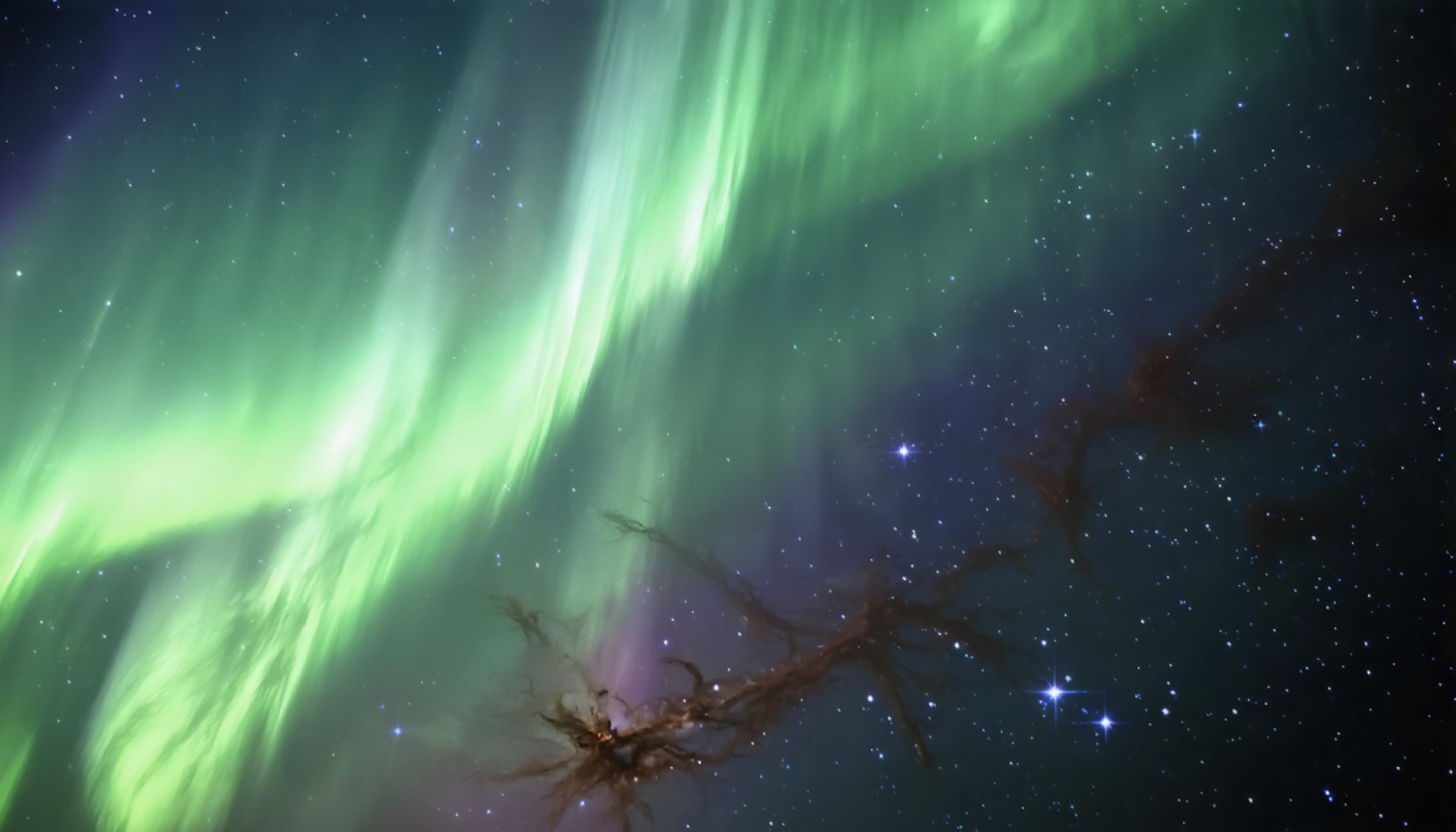- The James Webb Space Telescope has captured stunning images of Neptune’s auroras using its Near-Infrared Spectrograph (NIRSpec).
- Neptune’s auroras differ from Earth’s, appearing as intense cyan spots at mid-latitudes instead of polar ribbons of green and purple light.
- The telescope’s infrared capabilities provide insights into Neptune’s unique magnetic field and atmospheric dynamics.
- A strong emission from the trihydrogen cation illuminates Neptune’s auroras with brilliant blue hues.
- Astronomer Henrik Melin noted the unprecedented clarity of the auroras, linking cosmic phenomena with molecular interactions.
- These findings enhance our understanding of celestial mechanics and prompt further exploration of our solar system’s mysteries.
- The discoveries invite us to appreciate our planet’s beauty and inspire ongoing quests to comprehend the universe.
Out in the remote expanses of our solar system, a celestial show of color and light unfurls over Neptune, the icy behemoth. Astronomers, for the first time, have been able to capture vivid images of this spectacle thanks to NASA’s groundbreaking James Webb Space Telescope. Using its Near-Infrared Spectrograph (NIRSpec), it has managed to see the far-off planet’s mysterious auroras in astonishing detail, reframing our understanding of this distant world.
Unlike the familiar auroras on Earth, which grace the poles with undulating ribbons of green and purple, Neptune’s light show presents as intense cyan spots that bizarrely manifest at mid-latitudes. This stark difference has thrilled scientists and ignited curiosity. What fuels these planetary light displays so differently, and what secrets might they reveal about Neptune’s magnetic field and atmosphere?
The invisible rays of infrared light are Webb’s specialty, allowing it to do what Voyager 2 could not during its flashing flyby back in 1989: pinpoint and image Neptune’s auroras with precision. These ethereal bursts are not merely visual phenomena but reveal much about the composition and dynamics of Neptune’s atmosphere. Webb detected a strong emission line from the trihydrogen cation, a luminescent molecule integral to auroral displays, particularly in these astonishing blue hues.
Henrik Melin, diligently working on this project from Northumbria University, expressed sheer awe at the unprecedented clarity of Neptune’s auroral, amplified by Webb’s capabilities. The intricate detail captured does more than inspire wonder—it builds a bridge linking cosmic movements with molecular interactions, a fitting tribute to the marvels of modern astronomy.
Such discoveries not only pique scientific curiosity but expand our grasp of celestial mechanics across the solar neighborhood. Each glimpse into Neptune’s glowing atmospheres extrapolates questions about other mysteries waiting to be uncovered by this new eye in the cosmos. What other celestial secrets remain shrouded in the depths of space, waiting patiently for our vision to finally clear?
These celestial phenomena remind us of our own planet’s mesmerizing beauty while urging us to embark on interstellar journeys of imagination and exploration. The majesty of Neptune’s auroras doesn’t just illuminate the icy planet — it lights the way to our ever-deepening quest to understand the universe around us.
Experience Neptune’s Auroras: A New View with James Webb Space Telescope
Unveiling Neptune’s Mysteries with James Webb Space Telescope
The discovery of Neptune’s stunning auroras, captured by NASA’s James Webb Space Telescope, marks a significant leap in our understanding of the solar system’s outer realms. Here’s what you need to know about these celestial phenomena and the groundbreaking technology that made their observation possible.
Understanding Neptune’s Unique Auroras
Neptune’s auroras differ vastly from the Earth’s green and purple lights, appearing instead as intense cyan spots. These displays occur at mid-latitudes, a noteworthy departure from the polar-focused auroras observed on Earth. Scientists are enthralled by what these differences reveal about Neptune’s magnetic field and atmospheric composition, including the presence of trihydrogen cation, a molecule fundamental to these displays.
Key Features & Technology of Webb’s Observations
– Near-Infrared Spectrograph (NIRSpec): Webb’s advanced NIRSpec allows it to peer beyond visible light, capturing the planet’s auroras with unprecedented clarity. This capability is vital for studying the composition and dynamics of Neptune’s atmosphere.
– Trihydrogen Cation Detection: The strong emission line from this molecule in Neptune’s auroras provides insights into the interactions and movements within the planet’s atmosphere.
– Enhanced Imaging: Webb’s ability to capture these phenomena from a distance surpasses the capabilities of previous missions, like Voyager 2, which provided only fleeting glimpses of the planet in the late ’80s.
Pressing Questions and Scientific Insights
What fuels Neptune’s auroras?
Neptune’s auroras are thought to be driven by interactions between the solar wind and its magnetic field, much like Earth’s auroras. However, their unique manifestation suggests differences in its magnetic environment and atmospheric conditions.
What secrets might Neptune’s auroras reveal?
Neptune’s auroras offer potential insights into the planet’s magnetic field characteristics, atmospheric composition, and how these factors influence planetary weather and climate. Understanding these can inform broader astronomical theories and models.
Real-World Applications and Future Exploration
Beyond enriching our knowledge of Neptune, these observations could shed light on atmospheric processes on exoplanets and refine our methods for detecting and studying distant worlds.
– Market Forecasts & Industry Trends: The success of the James Webb Space Telescope may pave the way for future space telescopes and observational technology, driving innovations and investments in space exploration industries.
– Security & Sustainability: Understanding celestial bodies’ atmospheres may play a crucial role in long-term space exploration and potential extraterrestrial colonization strategies.
Actionable Recommendations
1. Follow NASA’s Updates: Stay tuned to NASA’s official site for the latest findings from the James Webb Space Telescope.
2. Engage with Astronomy Communities: Joining local or online astronomy clubs can enhance your understanding and appreciation of these discoveries.
3. Utilize Educational Resources: Platforms like Khan Academy offer courses on astronomy and planetary science, perfect for both enthusiasts and students.
Conclusion
The unveiling of Neptune’s auroras by the James Webb Space Telescope is more than a scientific marvel; it’s an invitation to explore the cosmos beyond our current horizons. By understanding the secrets of our distant solar neighbors, we edge closer to unraveling the mysteries of the universe itself.
